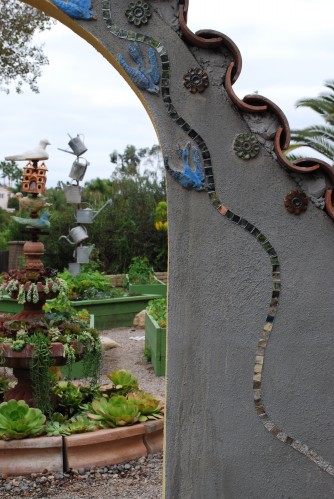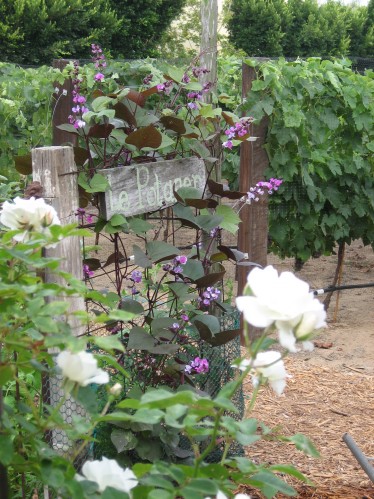 Remember my dear friend, Kathy Lafleur, who has the incredible mosaic-decorated chicken coop? See VintageGardenGal's related post, Chicken Coop FAQ. Well, she has been working hard on her potager, and has allowed us to catch a glimpse.
Remember my dear friend, Kathy Lafleur, who has the incredible mosaic-decorated chicken coop? See VintageGardenGal's related post, Chicken Coop FAQ. Well, she has been working hard on her potager, and has allowed us to catch a glimpse.
If you recall in a previous post,7 Elements of a Potager I emphasized that you must create a potager in your personal style. Kathy has done an amazing job of emphasizing her potager elements in her personal style.
Kathy's entrance into her potager is a newly designed archway "welcoming" you to come in. A work in progress, she has made and grouped clay bluebirds and mirror squares, as her beginning mosaic design. On the opposite side of this arch she has planned a surprise for those entering her potager, two espaliered fig trees, whose structure and design will eventually echo the curved archway.
Look closely through her archway and you can see two tall focal points, the first one, a towering Spanish three-tiered fountain, replacing water with heat-loving spilling succulents. More of Kathy's artistic ceramic birds adorn its top and pay homage to the "goodness of the garden." The second towering focal point is her genius "totem" pole, created from her inspiring collection of European vintage watering cans. A straight rod anchors each watering can, and keeps them precariously in place. Kathy's watering can "totem" pole, is an excellent example of repetition. See VintageGardenGal's related post, "Repetition is Design". The simplest things in repetition can create fabulous design.
The heart and soul of any potager are the plots or raised beds. Kathy has several raised beds painted in a vibrant green, to show off each season's vegetables and flowers. Ample gravel pathways allow easy access and working area for each raised bed. Her entire potager is enclosed by a low clay brick wall, enclosure another important element of the potager.
Kathy Lafleur's potager is so inviting, so artistically well-done, when you are in her potager you don't want to leave. It is as functional as a kitchen garden, as it is artistically beautiful to enjoy. When planning your potager, create it in your personal style.
Have you thought of mixing art with functionality in your potager? Do you have a favorite collection you can create something with?

